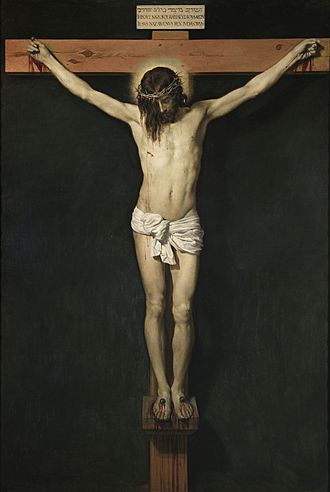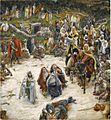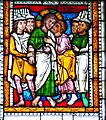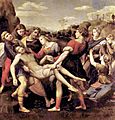Crucifixion of Jesus facts for kids
Quick facts for kids 
The 17th-century painting Christ Crucified by Diego Velázquez, held by the Museo del Prado in Madrid
|
|
| Date | AD 30/33 |
|---|---|
| Location | Jerusalem, Judea, Roman Empire |
| Participants | Jesus, Roman Army |
The crucifixion of Jesus is a very important event in Christianity. It happened in ancient Judea, which was part of the Roman Empire, most likely around 30 or 33 AD. This event is described in the four main Gospels of the Bible. It is also mentioned in other parts of the New Testament and by other ancient writers.
Most historians agree that Jesus' crucifixion was a real historical event, even if they don't agree on every small detail.
According to the Gospels, Jesus was arrested and put on trial by a Jewish council. Then, Pontius Pilate, a Roman governor, sentenced him to be whipped and then crucified by the Romans.
Jesus' clothes were taken from him. He was offered a sour drink, possibly posca, after he said, "I am thirsty." He was then hung on a cross between two criminals. The Gospel of Mark says he died in the afternoon, around 3:00 p.m.
During this time, Roman soldiers put a sign on top of the cross. It said "Jesus of Nazareth, King of the Jews." The Gospel of John says this sign was written in three languages: Hebrew, Latin, and Greek. The soldiers also divided Jesus' clothes among themselves. They gambled for his special seamless robe.
The Gospel of John also says that after Jesus died, a soldier used a spear to pierce his side to make sure he was dead. The Bible says that blood and water came out of the wound. The Bible also describes seven things Jesus said while he was on the cross. It also mentions several amazing things that happened at that time.
Christians call Jesus' suffering and death on the cross the "Passion." This event is a central part of Christian theology. It helps explain how Christians believe people can be saved and forgiven for their sins.
Images for kids
-
Bronzino's depiction of the crucifixion with three nails, no ropes, and a hypopodium standing support, c. 1545.
-
Crucifixion of Jesus of Nazareth, medieval illustration from the Hortus deliciarum of Herrad of Landsberg, 12th century
-
Andrea di Bartolo, Way to Calvary, c. 1400. The cluster of halos at the left are the Virgin Mary in front, with the Three Marys.
-
Crucifixion, seen from the Cross, by James Tissot, c. 1890, Brooklyn Museum
-
Christ on the Cross, by Carl Heinrich Bloch, showing the skies darkened
-
Bronzino's Deposition of Christ
-
Adoration of the Mystic Lamb (detail of the Ghent Altarpiece, Jan van Eyck, c. 1432). Christ is represented as the sacrificial Lamb of God.
-
Detail of the countenance of Christ just dead, by José Luján Pérez, 1793, Las Palmas Cathedral
-
Betrayal of Christ, stained glass, Gotland, Sweden, 1240
-
Orthodox Crucifixion icon, Athens, Greece
-
Crucifixion of Christ, Michelangelo, 1540
-
Calvary by Paolo Veronese, 16th century
-
From a 14th–15th century Welsh Manuscript
-
Pietro Lorenzetti fresco, Assisi Basilica, 1310–1329
-
Descent from the Cross, Raphael, 1507
See also
 In Spanish: Crucifixión de Jesús para niños
In Spanish: Crucifixión de Jesús para niños





















